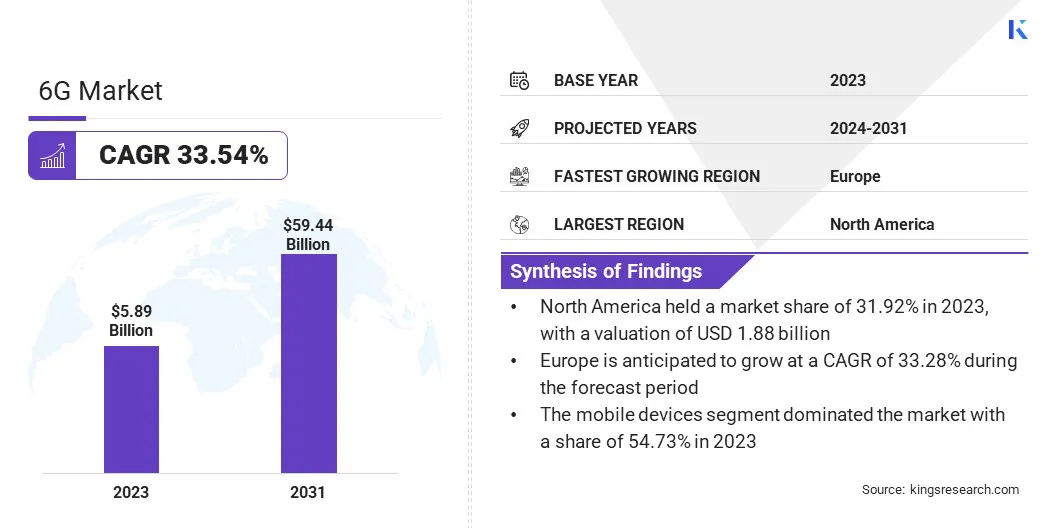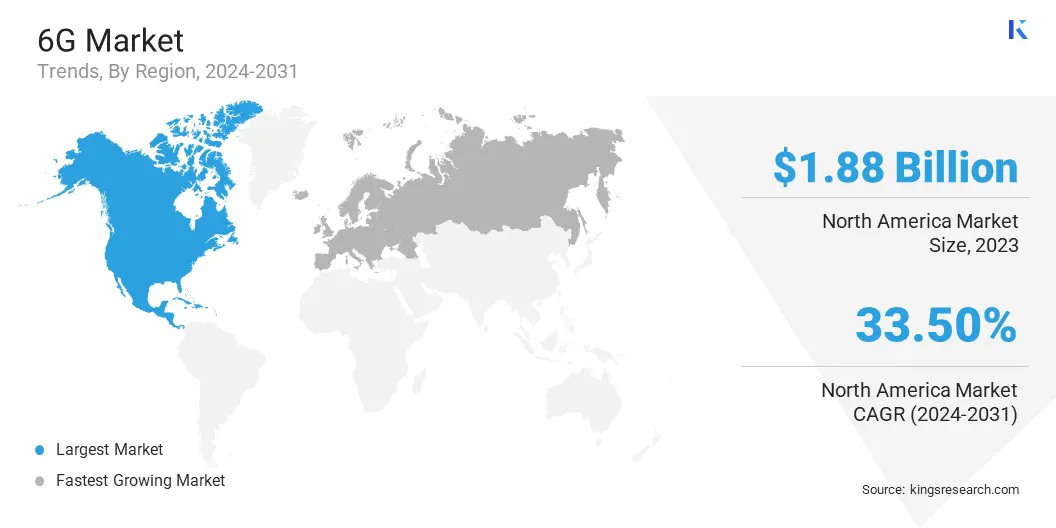6G Market Size
The global 6G Market size was valued at USD 5.89 billion in 2023 and is projected to reach USD 59.44 billion by 2031, growing at a CAGR of 33.54% from 2024 to 2031. In the scope of work, the report includes solutions offered by companies such as Samsung, Telefonaktiebolaget LM Ericsson, Nokia, Huawei Technologies Co., Ltd., Fujitsu, AT&T, Cisco Systems, Inc., Keysight Technologies, DeepSig Inc., NEC Corporation and Others.
Government investments in next-generation network infrastructure serve as a pivotal driver propelling the development of the global market. The investments aim to bolster national competitiveness, spur innovation, and address emerging challenges such as the digital divide and cybersecurity threats.
Governments are partnering with industry stakeholders to accelerate research and development initiatives, foster collaboration among education, private sector, and government agencies, and establish conducive regulatory frameworks to facilitate the seamless rollout of 6G networks.
By prioritizing investments in next-generation infrastructure, governments are laying the groundwork for a future-ready digital economy in the global 6G industry.
6G, the sixth generation of wireless communication technology, represents a paradigm shift in connectivity characterized by unprecedented speed, ultra-low latency, and ubiquitous connectivity.
Unlike its predecessors, 6G is envisioned to transcend traditional boundaries, extending beyond smartphones and tablets to encompass a diverse array of devices ranging from autonomous vehicles and smart appliances to industrial sensors and wearable gadgets. Industries spanning healthcare, manufacturing, transportation, and entertainment, among others, are poised to benefit from the transformative potential of 6G, creating new opportunities for innovation, efficiency, and economic growth.

Analyst’s Review
The 6G market outlook is characterized by optimism and anticipation for the next wave of technological innovation. As 5G deployment gains momentum globally, the focus on the development and commercialization of 6G technologies is growing.
While 6G networks are still in the early stages of research and standardization, stakeholders across the industry are actively exploring the possibilities and potential applications of this emerging technology.
The robust growth of the market is likely to be driven by increasing demand for high-speed, low-latency connectivity, proliferation of connected devices, and growing emphasis on digital transformation across various sectors.
With the proliferation of connected devices and the exponential growth of data traffic, the need for comprehensive security solutions to protect 6G networks against cyber threats is growing.
6G Market Growth Factors
Expanding applications in smart cities, autonomous vehicles, and remote healthcare are major factors shaping the evolution of the global 6G market. As cities strive to be connected, efficient, and sustainable, the deployment of 6G networks is expected to support the development of smart infrastructure.
Moreover, autonomous vehicles rely on ultra-fast, reliable communication networks to navigate complex environments and ensure passenger safety. In the healthcare sector, 6G technology holds the potential to revolutionize telemedicine and remote patient monitoring, facilitating timely diagnosis, treatment, and intervention regardless of geographical barriers.
However, the high costs associated with 6G infrastructure development and deployment pose a significant restraint to the widespread adoption of this next-generation technology. Building robust 6G networks requires substantial investments in research, spectrum allocation, equipment manufacturing, and network rollout.
Moreover, the complexity of 6G technology, is underscored by its emphasis on advanced features such as terahertz frequencies, massive MIMO, and network slicing, thereby escalating the costs.
Additionally, the deployment of 6G infrastructure entails upgrading existing infrastructure and building entirely new networks, which is both time-consuming and capital-intensive.
These high costs present a barrier for network operators, governments, and businesses looking to invest in 6G, particularly in regions with limited financial resources or infrastructure development.
To overcome this challenge, industry players are focusing on collaborative efforts, innovative financing models, and supportive regulatory policies to mitigate the financial burden and accelerate the adoption of 6G technology.
6G Market Trends
The convergence of the physical and digital worlds with AR/VR integration is a transformative trend shaping the landscape of the global 6G market. Augmented reality (AR) and virtual reality (VR) technologies are influencing various industries, spanning from gaming and entertainment to healthcare and education.
With the advent of 6G networks, these immersive technologies are poised to push boundaries, enabling seamless, high-fidelity experiences that blend the physical and virtual realms.
By providing ultra-fast, low-latency connectivity, 6G networks facilitate real-time rendering, high-definition streaming, and interactive collaboration, thereby enhancing the immersive capabilities of AR/VR applications.
The synergistic convergence of AR/VR technologies with advanced 6G networks present unparalleled opportunities to transform digital interaction across diverse sectors, from enhancing remote collaboration and training initiatives to redefining consumer experiences and virtual tourism.
Segmentation Analysis
The global 6G market is segmented based on device, vertical, and geography.
By Device
Based on device, the market is segmented into mobile devices, IoT and edge computing devices, and others. The mobile devices segment dominated the market with a share of 54.73% in 2023 due to the widespread adoption of smartphones, tablets, and other portable devices that rely heavily on wireless connectivity.
With the proliferation of mobile internet usage and the increasing demand for high-speed data transmission, consumers are increasingly adopting advanced mobile devices equipped with 5G capabilities.
These devices offer faster download and upload speeds, enabling seamless streaming, gaming, and communication experiences. This has led mobile device manufacturers to focus on 5G innovation, by launching a plethora of 5G-enabled smartphones and tablets to meet consumer demand.
This surge in adoption of mobile device has propelled the mobile devices segment to dominate the market, commanding the majority share of 6G-related investments, research, and development.
By Vertical
Based on vertical, the market is classified into agriculture, automotive, educational & entertainment, healthcare, government, manufacturing, and others. The government segment is anticipated to witness the highest growth of 35.50% over the forecast period.
The increasing investments in national infrastructure development, cybersecurity, and digital transformation initiatives are propelling the market growth. Governments play a crucial role in shaping the trajectory of the 6G market through policy formulation, regulatory oversight, and funding allocation.
As nations strive to enhance their digital infrastructure, bolster national security, and stimulate economic growth, government agencies are increasing their investments in next-generation communication technologies, including 6G.
Furthermore, governments are recognizing the strategic importance of 6G in enabling critical applications such as smart cities, autonomous vehicles, and remote healthcare, which require robust and reliable connectivity.
6G Market Regional Analysis
Based on region, the global 6G market is classified into North America, Europe, Asia Pacific, MEA, and Latin America.

The North America 6G Market share stood around 31.92% in 2023 in the global market, with a valuation of USD 1.88 billion, mainly fueled by its early adoption of 5G technology, a robust ecosystem of technology innovators, and strong consumer demand for high-speed connectivity.
The region's advanced digital infrastructure, supportive regulatory environment, and expanding startup ecosystem have created a conducive environment for the development and deployment of 6G networks and services. Major players are investing heavily in research and development, strategic partnerships, and infrastructure upgrades, thereby supporting region market growth.
Europe is likely to experience significant growth at a 33.28% CAGR between 2024 and 2031 owing to its strong commitment to digitalization, robust research and innovation ecosystem, and proactive regulatory approach.
As the European Union prioritizes digital transformation as a key factor supporting economic growth and competitiveness, member states are making significant investments in next-generation communication technologies, including 6G.
Moreover, Europe boasts a dynamic startup ecosystem, renowned research institutions, and a skilled workforce, furnishing a robust groundwork for innovation and technology leadership in the 6G space.
Additionally, Europe's focus on sustainability, privacy, and data protection aligns with the principles driving the development of 6G, positioning it as a key region in shaping the landscape of wireless communications.
Competitive Landscape
The global 6G market will provide valuable insight with an emphasis on the fragmented nature of the industry. Prominent players are focusing on several key business strategies such as partnerships, mergers and acquisitions, product innovations, and joint ventures to expand their product portfolio and increase their market shares across different regions.
Widely adopted strategic initiatives, including investments in R&D activities, the establishment of new manufacturing facilities, and supply chain optimization are positively influencing the market outlook.
List of Key Companies in 6G Market
- Samsung
- Telefonaktiebolaget LM Ericsson
- Nokia
- Huawei Technologies Co., Ltd.
- Fujitsu
- AT&T
- Cisco Systems, Inc.
- Keysight Technologies
- DeepSig Inc.
- NEC Corporation
Key Industry Developments
- April 2024 (Partnership): NTT DOCOMO, INC., NTT Corporation, NEC Corporation, and Fujitsu collectively unveiled a cutting-edge wireless device designed for ultra-high-speed 100 Gbps transmissions within the 100 GHz and 300 GHz sub-terahertz bands. This announcement follows their collaborative research and development efforts on sub-terahertz devices, demonstrating their commitment to advancing telecommunications technology.
The Global 6G Market is Segmented as:
By Device
- Mobile Devices
- IoT and Edge Computing Devices
- Others
By Vertical
- Agriculture
- Automotive
- Educational & Entertainment
- Healthcare
- Government
- Manufacturing
- Others
By Region
- North America
- Europe
- France
- U.K.
- Spain
- Germany
- Italy
- Russia
- Rest of Europe
- Asia-Pacific
- China
- Japan
- India
- South Korea
- Rest of Asia-Pacific
- Middle East & Africa
- GCC
- North Africa
- South Africa
- Rest of Middle East & Africa
- Latin America
- Brazil
- Argentina
- Rest of Latin America


